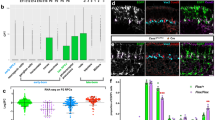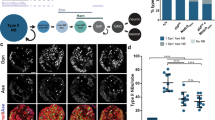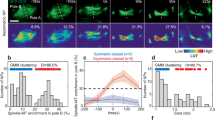Abstract
The generation of cellular diversity is essential in embryogenesis, especially in the central nervous system. During neurogenesis, cell interactions or asymmetric protein localization during mitosis can generate daughter cells with different fates1,2,3,4. Here we describe the asymmetric localization of a messenger RNA and an RNA-binding protein that creates molecular and developmental differences between Drosophila neural precursors (neuroblasts) and their daughter cells, ganglion mother cells (GMCs). The prospero (pros) mRNA and the RNA-binding protein Staufen (Stau) are asymmetrically localized in mitotic neuroblasts and are specifically partitioned into the GMC, as is Pros protein5,6,7. Stau is required for localization of pros RNA but not of Pros protein. Loss of localization of Stau or of pros RNA alters GMC development, but only in embryos with reduced levels of Pros protein, suggesting that pros RNA and Pros protein act redundantly to specify GMC fate. We also find that GMCs do not transcribe the pros gene, showing that inheritance of pros RNA and/or Pros protein from the neuroblast is essential for GMC specification.
This is a preview of subscription content, access via your institution
Access options
Subscribe to this journal
Receive 51 print issues and online access
$199.00 per year
only $3.90 per issue
Buy this article
- Purchase on Springer Link
- Instant access to full article PDF
Prices may be subject to local taxes which are calculated during checkout




Similar content being viewed by others
References
McConnell, S. K. Constructing the cerebral cortex: neurogenesis and fate determination. Neuron 15, 761–768 (1995).
Guenther, C. & Garriga, G. Asymmetric distribution of the C. elegans HAM-1 protein in neuroblasts enables daughter cells to adopt distinct fates. Development 122, 3509–3518 (1996).
Jan, Y. N. & Jan, L. Y. Maggot's hair and bug's eye: role of cell interactions and intrinsic factors in cell fate specification. Neuron 14, 1–5 (1995).
Lin, H. & Schagat, T. Neuroblasts: a model for the asymmetric division of stem cells. Trends Genet. 13, 33–39 (1996).
Hirata, J., Nakagoshi, H., Nabeshima, Y. & Matsuzaki, F. Asymmetric segregation of the homeodomain protein Prospero during Drosophila development. Nature 377, 627–630 (1995).
Knoblich, J. A., Jan, L. Y. & Jan, Y. N. Asymmetric segregation of Numb and Prospero during cell division. Nature 377, 624–627 (1995).
Spana, E. & Doe, C. Q. The prospero transcription factor is asymmetrically localized to the cell cortex during neuroblast mitosis in Drosophila. Development 121, 3187–3195 (1995).
Doe, C. Q., Chu-LaGraff, Q., Wright, D. M. & Scott, M. P. The prospero gene specifies cell fates in the Drosophila central nervous system. Cell 65, 451–464 (1991).
Vaessin, H. et al. prospero is expressed in neuronal precursors and encodes a nuclear protein that is involved in the control of axonal outgrowth in Drosophila. Cell 67, 941–953 (1991).
Ferrandon, D., Elphick, L., Nüsslein-Volhard, C. & St Johnston, D. Staufen protein associates with the 3′ UTR of bicoid mRNA to form particles that move in a microtubule-dependent manner. Cell 79, 1221–1232 (1994).
St Johnston, D., Beuchle, D. & Nüsslein-Volhard, C. staufen, a gene required to localize maternal RNA in the Drosophila egg. Cell 66, 51–63 (1991).
Li, P., Yang, X., Wasser, M., Cai, Y. & Chia, W. Inscuteable and Staufen mediate asymmetric localization and segregation of prospero RNA during Drosophila neuroblast cell divisions. Cell 90, 437–447 (1997).
Broadus, J. & Doe, C. Q. Extrinsic cues, intrinsic cues, and microfilaments regulate asymmetric protein localization in Drosophila neuroblasts. Curr. Biol. 7, 827–835 (1997).
Matsuzaki, F., Koisumi, K., Hama, C., Yoshioka, T. & Nabeshima, Y. Cloning of the Drosophila prospero gene and its expression in ganglion mother cells. Biochem. Biophys. Res. Commun. 182, 1326–1332 (1992).
Long, R. M. et al. Mating type switching in yeast controlled by asymmetric localization of ASH1 mRNA. Science 277, 383–387 (1997).
Takizawa, P. A., Sil, A., Swedlow, J. R., Herskowitz, I. & Vale, R. D. Actin-dependent localization of an RNA encoding a cell-fate determinant in yeast. Nature 389, 90–93 (1997).
Bobola, N., Jansen, R.-P., Shin, T. & Nasmyth, K. Asymmetric accumulation of Ash1p in postanaphase nuclei depends on a myosin and restricts yeast mating-type switching to mother cells. Cell 84, 699–709 (1996).
Bodmer, R., Carretto, R. & Jan, Y. N. Neurogenesis of the peripheral nervous system in Drosophila embryos: DNA replication patterns and cell lineages. Neuron 3, 21–32 (1989).
Lundell, M. J. & Hirsch, J. Anew visible light fluorochrome for confocal microscopy. Biotechniques 16, 434–440 (1994).
Broadus, J. B. & Doe, C. Q. Evolution of neuroblast identity: seven-up and prospero expression reveal homologous and divergent cell fates in Drosophila and Schistocerca. Development 121, 3989–3996 (1995).
Patel, N. H., Schafer, B., Goodman, C. S. & Holmgren, R. The role of segment polarity genes during Drosophila neurogenesis. Genes Dev. 3, 890–904 (1989).
Shen, C.-P., Jan, L. Y. & Jan, Y. N. Miranda is required for the asymmetric localization of Prospero during mitosis in Drosophila. Cell 90, 449–458 (1997).
Ikeshima-Kataoka, H., Skeath, J. B., Nabeshima, Y., Doe, C. Q. & Matsuzaki, F. Miranda directs Propsero to a daughter cell during Drosophila asymmetric divisions. Nature 390, 625–629 (1997).
Acknowledgements
We thank C.-Y. Peng for help with genetics; C.-Y. Peng, F. Matsuzaki and B. Chia for sharing unpublished results; D. St Johnston for Stau antiserum; E. Spana for pros intron DNA; and C.Thummel and F. Gertler for comments. This work was supported by an NIH postdoctoral fellowship to S.F. and by the HHMI, of which C.Q.D. is an associate investigator.
Author information
Authors and Affiliations
Rights and permissions
About this article
Cite this article
Broadus, J., Fuerstenberg, S. & Doe, C. Staufen-dependent localization of prospero mRNA contributes to neuroblast daughter-cell fate. Nature 391, 792–795 (1998). https://doi.org/10.1038/35861
Received:
Accepted:
Issue Date:
DOI: https://doi.org/10.1038/35861
This article is cited by
-
Therapeutic Effectiveness of Anticancer Agents Targeting Different Signaling Molecules Involved in Asymmetric Division of Cancer Stem Cell
Stem Cell Reviews and Reports (2023)
-
Dynamics of maternal gene expression in Rhodnius prolixus
Scientific Reports (2022)
-
The multifunctional RNA-binding protein Staufen1: an emerging regulator of oncogenesis through its various roles in key cellular events
Cellular and Molecular Life Sciences (2021)
-
Innate and adaptive resistance to RNAi: a major challenge and hurdle to the development of double stranded RNA-based pesticides
3 Biotech (2021)
-
Kruppel-like factor 4-dependent Staufen1-mediated mRNA decay regulates cortical neurogenesis
Nature Communications (2018)
Comments
By submitting a comment you agree to abide by our Terms and Community Guidelines. If you find something abusive or that does not comply with our terms or guidelines please flag it as inappropriate.



